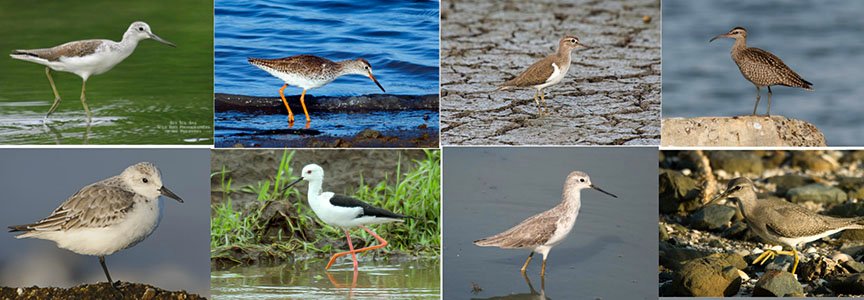
Migration is the seasonal changes behaviour of the birds as they move between their winter homes and summer breeding grounds. In fall they usually leave their breeding areas where the weather is severe and food sources are not plentiful, resources-rich environments while in spring they return to breeding areas. Migration is an extremely diverse behaviour found in all animal taxa.Migration of the birds is a natural seasonal opportunity for breeding, habitats, and feeding. It is a widespread phenomenon in nature. Animals exhibits different types of migration that includes seasonal migration over latitudes, altitudinal, migrations that extend over with life-history stages such as molt, and migrations that can cross multiple generations over time and space. This alteration occurs between species or within species, but all types of migration includes action from their original origin and the react back to it. The geographical association of organisms between certain stages of annual cycle, which includes winter stages and migration, and breeding is called as Migration Connectivity. Migratory Connectivity, however, it may be weak or strong. Migratory connectivity has an important consequence for the conservation of migratory organisms, evolution and ecology. These birds fly over the mountain ranges, river valleys, and other topographical features. Migration of birds is driven primarily in search of food, habitat, breeding, nourishment etc. Migration costs high mortality when hunted by humans.
Migratory Birds
Wetlands play an important role in the health and existence of other natural resources of the state, like ground water, inland lakes, fisheries and wild life. Most of the wetlands are seems to be the resident of migratory birds, aquatic vegetation and fish fauna. Due to diverse weather and varied land of Pakistan play a role as a home for the exclusive and rare birds of the world and its wetlands and lakes attracts million of the birds from the globe especially from the Siberia each year. Migratory birds are those birds that travel across national and international borders, from Arctic to tropical or subtropical zones. Pakistan bears a wide range of wetlands distributed throughout the country which start from the coastal mangroves to glacial lakes of high Himalayas. Total wetland of Pakistan is about 7,800,000 ha. On the avifauna of Pakistan there are few reports presented. In these reported many of the wetlands of Pakistan are discussed which are Patisar lake of Bahawalpur, Rawal Lake Islamabad, Chashma Barrage and Marala headworks, Rasool Barrage Birds starting arrival in Pakistan in the beginning of winter season when started in Siberia (Russia) during September to November and these birds are mainly found on the costs of river Indus and Kabul. These birds are migrated from Siberia to Karakoram mountains, Afghanistan acrossing the river Indus in Pakistan and finally towards the India. This route is commonly called international migration route as `Green Route or Indus Fly-way No.4. Migratory species of birds can be divided into four categories which are: short-distance migrant, local migrant, long-distance and nomadic migrants. Species of birds like Falcons, Quails, Pheasants, Rails, Crakes, Moorhens, Coots, Pigeons, Doves, Owls, Woodpeckers, Wrynecks, Warblers, Flycatchers, Wagtails, Pipits, Shrikes, are kept under the category of migratory birds. Asian Houbara (Chlamydotis macqueenii) mainly found in cholistan desert of Pakistan and fly through the mountains of Himalaya Hindu kash, Tien Shan and Pamir.
Transmission
Transmission of pathogens occur through the migratory birds can take place directly (biological transmission) or indirectly (arthropod-borne transmission) to the indigenous livestock and humans. They act as a vector and can carry certain pathogens including parasites and act as a reservoir of host for transmitting certain microorganisms including Escherichia coli, Salmonella, Mycobacterium, West Nile virus and Avian Influenza virus to humans and animals.
2.3 Pathogens transmitted through migratory birds
2.3.1 Parasites
Haemoproteus spp., Leucocytozoon spp., Plasmodium spp., Trichomonas spp., Eimeria spp., Sarcosystis spp., Babesia spp. are significant members of Phylum Protozoa reported to be transmitted through migratory birds. Cestodes Species like Fermandezia spinnosissima, Monopylidium caenodex, Sobolevitaenia verulami, Hirundinicola chelidonariae, Aploparaksis (A.) Demshini, A. Scolopacis.
Cloacotaenia megalops is the only cestode which commonly found in cloaca. Beside these some of the undescribed species of Hymenolepis which main characteristic is strobila (2-5mm length) and scolex bearing 10 hooks was commonly found in duodenum of ducks reported to be transmitted through wild birds. Nematodes species that transmit through migratory birds includes Strongyloides are rarely or accidently found in lower digestive tract of wild ducks. Capillaria contorta mainly found in esophageal of ducks. Acuaria attenuate, Pseudoprocta decorate, Diploriaena ozouxi, Diplotriaena tridens, Dicheilonema ciconiae.
Trematodes includes Trichobilharzia sp., Dendritobilharzia pulverulenta was usually found in liver and kidneys. Typhlocoelum cucumerinum in trachea andPsilochasmus oxyurus, Levinseniella sp. are found in brackish water marshes. Other species are Epomidiostomum unicinatum, Capillaria spp., Tetrameras spp., Amidostomum acutum, Streptocara crassicauda, Sciadiocara rugosa, Porrocaecum crissum, strongyloides spp., Capillaria contorta, Sciadiocara rugosa.
2.3.2 Miscellaneous Pathogens
The following pathogens and diseases including Bacteria, Viral and Parasitic are below. Escherichia coli, Salmonella spp., Mycobacterium, Borrelia spp. Enterococcus, Staphylococcus, Clostridium perfringens, Listeria monocytogens, Yersinia spp., Enterobacteriaceae etc are bacterial pathogens while viral includesWest NileVirus, Louis encephalitis virus, Western Equine Encephalitis, Influenza A virus. Fungus includes Cryptococcus, Yeast, Candida sp., Aspergillus spp., Microsporum spp., Trichophyton spp. Schistosomes causing Cercarial dermatitis(swimmers itch), Coccidia and Sarcocystis are transmit through cranes, owls, ducks, waterfowls, cowbirds, andmallards.Ornithosis, Salmonellosis, enteritis, bloody diarrhea, Lyme disease. West Nile virus, Influenza, Encephalitis, Foot-and-mouth disease, rotavirus, CCHF, Egg-drop syndrome virus. Yeast, Candida spp., Aspergillus, Microsporum, Cryptococci.
Control and Prevention
eradication, neutralization of reservoirs, reducing potential contact, increasing host resistance, implementing consumer protection strategies, identifying animals appropriately, maintaining health, communication and education. It is necessary to require sufficient data regarding the movement of migratory birds, higher risk period for introduction and emergence of the bird-borne diseases. So, it becomes an essential component to understand the relation between migratory hosts, pathogens, predators, competitors and their environment.
The authors are associated with the Molecular Parasitology Lab, Department of Parasitology, UAF.